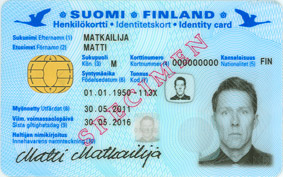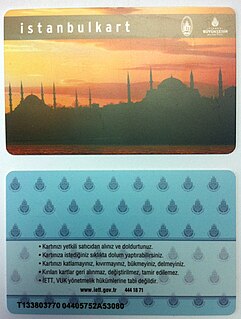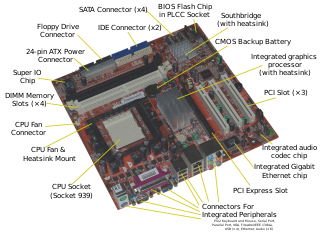
A smart card, chip card, or integrated circuit card (ICC) is a physical electronic authorization device, used to control access to a resource. It is typically a plastic credit card sized card with an embedded integrated circuit. Many smart cards include a pattern of metal contacts to electrically connect to the internal chip. Others are contactless, and some are both. Smart cards can provide personal identification, authentication, data storage, and application processing. Applications include identification, financial, mobile phones (SIM), public transit, computer security, schools, and healthcare. Smart cards may provide strong security authentication for single sign-on (SSO) within organizations. Several nations have deployed smart cards throughout their populations.
ISO/IEC 7816 is an international standard related to electronic identification cards with contacts, especially smart cards, managed jointly by the International Organization for Standardization (ISO) and the International Electrotechnical Commission (IEC).
Card standard(s) may refer to any of a number of standards related to smartcards.
ISO/IEC 14443Identification cards -- Contactless integrated circuit cards -- Proximity cards is an international standard that defines proximity cards used for identification, and the transmission protocols for communicating with it.

A memory card, flash card or memory cartridge is an electronic flash memory data storage device used for storing digital information. These are commonly used in portable electronic devices, such as digital cameras, mobile phones, laptop computers, tablets, PDAs, portable media players, video game consoles, synthesizers, electronic keyboards, and digital pianos.

A proximity card or prox card is a "contactless" smart card which can be read without inserting it into a reader device, as required by earlier magnetic stripe cards such as credit cards and "contact" type smart cards. The proximity cards are part of the contactless card technologies. Held near an electronic reader for a moment they enable the identification of an encoded number. The reader usually produces a beep or other sound to indicate the card has been read.

Near-field communication (NFC) is a set of communication protocols that enable two electronic devices, one of which is usually a portable device such as a smartphone, to establish communication by bringing them within 4 cm (1.6 in) of each other.
MIFARE is the NXP Semiconductors-owned trademark of a series of chips widely used in contactless smart cards and proximity cards.
A security token is a physical device used to gain access to an electronically restricted resource. The token is used in addition to or in place of a password. It acts like an electronic key to access something. Examples include a wireless keycard opening a locked door, or in the case of a customer trying to access their bank account online, the use of a bank-provided token can prove that the customer is who they claim to be.
FeliCa is a contactless RFID smart card system from Sony in Japan, primarily used in electronic money cards. The name stands for Felicity Card. First utilized in the Octopus card system in Hong Kong, the technology is used in a variety of cards also in countries such as Singapore, Japan, Indonesia and the United States.
ISO/IEC 15693, is an ISO standard for vicinity cards, i.e. cards which can be read from a greater distance as compared with proximity cards. Such cards can normally be read out by a reader without being powered themselves, as the reader will supply the necessary power to the card over the air (wireless).
ISO/IEC 7813 is an international standard codified by the International Organization for Standardization and International Electrotechnical Commission that defines properties of financial transaction cards, such as ATM or credit cards.

Payment cards are part of a payment system issued by financial institutions, such as a bank, to a customer that enables its owner to access the funds in the customer's designated bank accounts, or through a credit account and make payments by electronic funds transfer and access automated teller machines (ATMs). Such cards are known by a variety of names including bank cards, ATM cards, MAC, client cards, key cards or cash cards.
A card reader is a data input device that reads data from a card-shaped storage medium. The first were punched card readers, which read the paper or cardboard punched cards that were used during the first several decades of the computer industry to store information and programs for computer systems. Modern card readers are electronic devices that can read plastic cards embedded with either a barcode, magnetic strip, computer chip or another storage medium.

A contactless smart card is a contactless credential whose dimensions are credit-card size. Its embedded integrated circuits can store data and communicate with a terminal via NFC. Commonplace uses include transit tickets, bank cards and passports.
Calypso is an international electronic ticketing standard for microprocessor contactless smart cards, originally designed by a group of transit operators from 11 countries including Belgium, Germany, France, Italy, Latvia, Portugal, Canada and others. It ensures multi-sources of compatible products, and allows for interoperability between several transport operators in the same area.
In the context of smart cards, an application protocol data unit (APDU) is the communication unit between a smart card reader and a smart card. The structure of the APDU is defined by ISO/IEC 7816-4 Organization, security and commands for interchange.
An Answer To Reset (ATR) is a message output by a contact Smart Card conforming to ISO/IEC 7816 standards, following electrical reset of the card's chip by a card reader. The ATR conveys information about the communication parameters proposed by the card, and the card's nature and state.

istanbulkart is a contactless smart card for fare payment on public transport in Istanbul, Turkey. It was introduced on March 23, 2009 in addition to, and to eventually replace, the Akbil, an integrated electronic ticket system. The card was developed and put into practice by the information technology company Belbim of the Metropolitan Municipality.
ISO/IEC JTC 1/SC 17 Cards and personal identification is a standardization subcommittee of the Joint Technical Committee ISO/IEC JTC 1 of the International Organization for Standardization (ISO) and the International Electrotechnical Commission (IEC), which develops and facilitates standards within the field of identification cards and personal identification. The international secretariat of ISO/IEC JTC 1/SC 17 is the British Standards Institution (BSI) located in the United Kingdom.
















